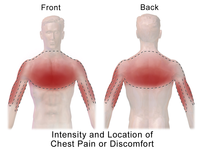
Photo from wikipedia
Abstract Purpose: To describe experiences of shoulder pain after stroke, how pain affects daily life and perceived effects of interventions. Method: A qualitative interview study including 13 community-dwelling persons (six… Click to show full abstract
Abstract Purpose: To describe experiences of shoulder pain after stroke, how pain affects daily life and perceived effects of interventions. Method: A qualitative interview study including 13 community-dwelling persons (six women; median age 65 years) with persistent shoulder pain after stroke. Results: Three categories emerged from the content analysis. In “Multiple pain characteristics” an insidious pain onset was reported. The pain existed both day and night and could be located around the shoulder girdle but also have radiation to the arm and hand. An explanation of the pain was seldom given. In “Limitations caused by the pain” it was described how the pain negatively influenced personal care, household activities and leisure, but also could lead to emotional reactions. In “Multiple pain interventions with various effects” a variety of interventions were described. Self-management interventions with gentle movements were perceived most effective. A restraint attitude to pain medication due to side effects was reported. Conclusions: Shoulder pain after stroke can lead to a variety of pain characteristics. As the pain is complex and may affect many important areas in a person’s life, multidisciplinary rehabilitation interventions are important. Implications for rehabilitation Shoulder pain after stroke can lead to a variety of pain characteristics with radiation to the arm and hand Shoulder pain often influence personal care, household activities and leisure negatively, which may lead to emotional reactions Self-management interventions with gentle movements are perceived most effective As the shoulder pain after stroke is complex, interventions by a multidisciplinary team may be needed
Journal Title: Disability and Rehabilitation
Year Published: 2018
Link to full text (if available)
Share on Social Media: Sign Up to like & get
recommendations!